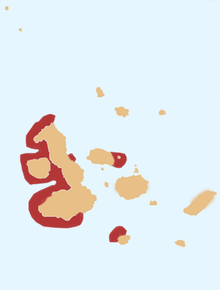This article needs additional citations for verification. (November 2023) |
| Galápagos penguin | |
|---|---|

| |
| Male swimming on Isabela Islands off Moreno Point, Galápagos Islands | |
| Scientific classification | |
| Domain: | Eukaryota |
| Kingdom: | Animalia |
| Phylum: | Chordata |
| Class: | Aves |
| Order: | Sphenisciformes |
| Family: | Spheniscidae |
| Genus: | Spheniscus |
| Species: | S. mendiculus
|
| Binomial name | |
| Spheniscus mendiculus Sundevall, 1871
| |

| |
| Distribution of the Galápagos penguin | |
The Galápagos penguin (Spheniscus mendiculus) is a penguin endemic to the Galápagos Islands of Ecuador. It is the only penguin found north of the equator.[4] Most inhabit Fernandina Island and the west coast of Isabela Island.[5] The cool waters of the Humboldt and Cromwell Currents allow it to survive despite the tropical latitude. The Galápagos penguin is one of the banded penguins, the other species of which live mostly on the coasts of Africa and mainland South America. Due to their warm environment, Galápagos penguins have developed techniques to stay cool. The feathers on their back, flippers, and head are black, and they have a white belly and a stripe looping from their eyes down to their neck and chin. Each penguin keeps only one mate,[5] and breeds year-round. Because there is no soft areas to nest, their nests are typically in caves and crevices[5] which also provide protection against predators and the harsh environment. The Galápagos penguin has a lifespan of 20 years,[5] but due to predation, life expectancy in the wild could be significantly reduced. They have been critically impacted to the point of endangerment by climate change and pollution caused by plastic waste due to tourism and urbanization.[6]
- ^ "Fossilworks: Spheniscus mendiculus". Archived from the original on 7 September 2023. Retrieved 1 February 2022.
- ^ "Fossilworks: Spheniscus". Archived from the original on 10 December 2023. Retrieved 1 February 2022.
- ^ Bird life International (2020). "Spheniscus mendiculus". IUCN Red List of Threatened Species. 2020: e.T22697825A182729677. doi:10.2305/IUCN.UK.2020-3.RLTS.T22697825A182729677.en.
- ^ "World Wide Fund for Nature – Galapagos Penguin Facts". World Wide Fund for Nature.
- ^ a b c d "Galapagos penguin". Galapagos Conservation Trust. Retrieved 13 June 2024.
- ^ Alava, Juan José; Palomera, Carlos; Bendell, Leah; Ross, Peter S. (2014), Denkinger, Judith; Vinueza, Luis (eds.), "Pollution as an Emerging Threat for the Conservation of the Galapagos Marine Reserve: Environmental Impacts and Management Perspectives", The Galapagos Marine Reserve: A Dynamic Social-Ecological System, Social and Ecological Interactions in the Galapagos Islands, Cham: Springer International Publishing, pp. 247–283, doi:10.1007/978-3-319-02769-2_12, ISBN 978-3-319-02769-2, retrieved 25 October 2023
